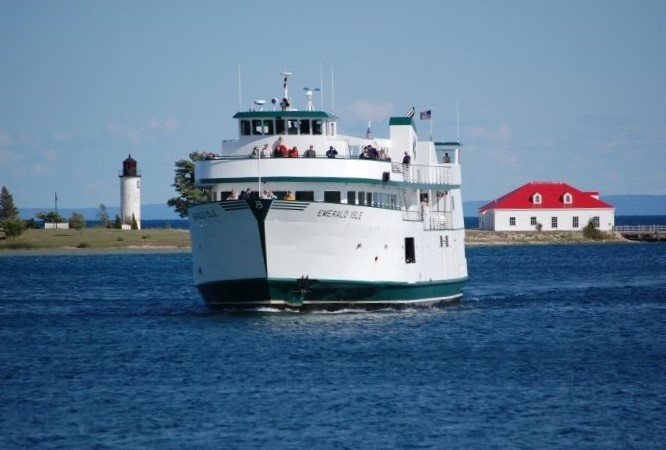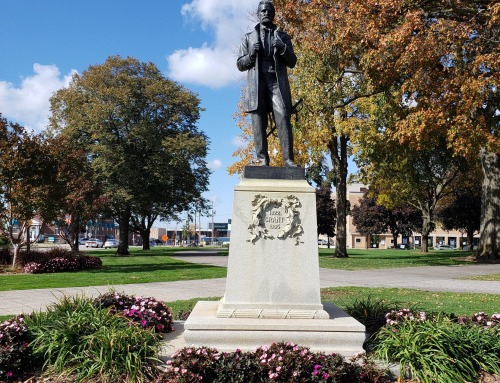Beaver Island is the third largest island in Michigan and has been a popular vacation tourist destination since the 1860s. It is well known for its beautiful beaches, awesome forests, recreational harbors and its isolation from the mainland. In addition to this, did you know that it has a colorful and unique history? This is especially true of a time when it was the site of a theocratic monarchy ruled by James Strang, a religious leader who broke away from the Church of Jesus Christ of Latter-day Saints. Strang crowned himself king of Beaver Island on July 8, 1850, which is why I decided on the history of this island for my article.
There are some references in colonial Michigan history to Beaver Island. French Jesuit priest, Fr. Francis Xavier de Charlevoix explored the Great Lakes in the 1720s and mentioned the island in his writings. The oral tradition of the Odawa tribe stated that there were small fishing villages in many of the bays of the island, and there have been many artifacts found, including arrowheads, spearheads and pottery to confirm this.
European Americans came to Beaver Island in the early 1800s earning a living by trading, trapping, fishing and cutting wood for passing steamboats. By the 1840s, the island established two trading forts that were thriving. In fact, for a time, Beaver Island had the most economic power in the region, even over Mackinac Island, because of its good fishing, ample forests and superior harbors. One of the largest communities on the island was made of Irish immigrants at Whiskey Point, yet many of the inhabitants were forced to leave the island in the 1850s by the next group to come to the island. Though before we go into details there, we must learn more about the early life of James Strang and his role in the Church of Latter-day Saints.
James Strang was born in Scipio, New York in 1813. He always expected to make a name for himself, and started this quest by getting his law degree. He met Joseph Smith, founder of the Church of Latter-day Saints, in 1844. Strang converted to the new religion, and his leadership and debating skills impressed Smith. Strang was sent to establish a branch of the church in Wisconsin. While he was away, Smith was assassinated in Carthage, Illinois. The founder had made many enemies, and an armed mob attacked Smith and he was shot multiple times before falling out of a window.
Back in Wisconsin, Strang produced a letter from Smith that named him the new leader of the Mormons. Many other leaders claimed the title of successor, including Brigham Young. Young had the most support to take over, so those who accepted Strang as the leader went to Nauvoo, Illinois, then Voree, Wisconsin. They were heavily persecuted in Wisconsin, so in 1848, Strang decided that God wanted him to bring his congregation to Beaver Island. They arrived within the year and their numbers quickly grew. Strang’s followers called themselves Strangites and became a political power in the region. They founded the town of St. James, named after Strang, on the northern part of the island and constructed Kings Highway down the middle of the island. They also cleared much of the land and built cabins, farms, and attempted to establish themselves permanently on the island.
Strang and his followers often conflicted with the Irish who had remained on the island. He was regularly accused of forcefully seizing their property and physically assaulting them. Open hostility was often violent. An example of that is the War of Whiskey Point. Strang wanted to rid the island of alcohol, but the Irish had used whiskey as currency for years, especially when trading with the Native Americans in the area. Days before the war broke out, Strang killed a man for refusing to pay an illegal tax he had demanded of non-Mormons. Many of the Irish were riled up and threatened to expel the Mormons from Beaver Island. In retaliation, Strang had a cannon fired across the harbor at a gathering of the Irish. No one was killed, but many of the Irish and other non-Mormons soon fled to neighboring islands. This paved the way for Strang to grab complete power. And he did.
On July 8, 1850, James Strang’s ambition pushed him even further. He proclaimed himself king of his church, holding an elaborate ceremony and was even given a crown. Since his congregation included most of Beaver Island’s inhabitants, he undoubtedly believed he could control the rest of the land, and his actions showed that.
Strang continued to acquire power. He was elected to the state legislature in 1853 and 1855, giving him more and more prestige. He founded the Northern Islander, the first newspaper in Northern Michigan. Strang also became a polygamist at this time, a practice that he had denounced in prior years. By the time he died, he had five wives and fourteen children.
Strang wasn’t all bad. In fact, one could say that his progressive ideas about the conservation of woodlands helped preserve the island’s beauty. However, these thoughts are overshadowed by his tyrannical rule which would eventually lead to his death. One of his edicts decreed what all Strangite women should wear. When two of his female followers refused, Strang had their husbands flogged. While the two men were recovering, they conspired to get rid of their overbearing leader.
On June 16, 1856, Strang was invited aboard the USS Michigan, which had docked at the St. James harbor. After his visit, Strang walked along the dock and was shot from behind by the two conspirators. Neither man was arrested or convicted, and it is assumed that they escaped on the gunboat, which departed, likely bringing the men to Mackinac Island.
Strang died of his wounds on July 9, 1856, and shortly after, mobs from Mackinac Island and St. Helena Island arrived and expelled the Strangites from Beaver Island reclaiming the island. By then, Strang’s followers numbered approximately 2,600.
Local government in Manitou County, which included Beaver Island, almost ceased as life returned to normal. Court sessions and elections were rarely held, county offices were often vacant, and the region acquired a lawless reputation. In 1877, Michiganian Governor John J. Bagley affirmed this reputation when he advocated for abolition of the county. A bill was introduced to accomplish this, but failed to be enacted. A second attempt in 1895 was successful, and Beaver Island was incorporated into Charlevoix County while Fox and Manitou Islands were incorporated into Leelanau County.
Life on Beaver Island turned much calmer after the Mormons left. Irish fishermen from Gull Island, Mackinac Island, and various port cities of mainland Michigan, returned to the island and were joined by emigrants from County Donegal, Ireland. Their community developed a unique identity that the isolation of the Island from the mainland fostered, and Beaver Island became known as “America’s Emerald Isle”. Church liturgy and even everyday conversations were in Gaelic for many years. One notable priest was Father Peter Gallagher, who served from 1865 to 1898, and was a colorful and charismatic leader who dominated society. He spoke Gaelic, which was desirable for the heavily Irish population, but had his flaws. He once engaged one of his parishioners in a fistfight in the chapel.
By the middle of the 1880s the Island became the largest supplier of freshwater fish consumed in the USA. Unfortunately, overfishing and technological changes ended this dominance by 1900.
Another notable man to make his mark on Beaver Island was Feodor Protar. Protar was born in Russia and arrived in 1893. He had been a disciple of Russian author and pacifist Leo Tolstoy and served as a local doctor and reportedly a friend to all, while living as a recluse in a cabin in the interior of the Island. Protar died in 1925 and left many admirers. His cabin has been placed on the National Registry of Historic Places by the US Department of the Interior.
Logging, which was always an important part of the island economy, greatly increased with the formation of the Beaver Island Logging Company in 1901. Docks, housing, railroads and a mill impacted the local scenery, while fishing continued as the primary economic activity. Another decrease of the fish population in the 1940s caused most of the residents to leave the island in search of jobs but by the 1970s, tourism renewed interest in the Island.
Today, you can still visit this island with its interesting history. Getting there is part of the adventure. You can go either by ferry or plane from Charlevoix, Michigan. There are actually two airlines serving Beaver Island daily year-round and the car ferry service runs from April to around Christmas. You can explore the island and see Beaver Head Island Lighthouse, built in 1858, which has been a school since 1975. You can go to Kilty’s Point and catch a beautiful sunrise, or if you’re more of a night-owl, head to the public beach on Donegal Bay, on the island’s northwest tip. Here, you can view the sparkling Milky Way clearly, due to civilization-free dark skies, and with a little luck, you can even see the Northern Lights if the conditions are right. Charter a fishing trip, take a ride in a kayak, canoe, or bike, then raise your glass in true Irish style at one of the many pubs or restaurants on the island. No matter what you enjoy you will find something to peak your interest in this beautiful Michigan paradise.







Leave A Comment
You must be logged in to post a comment.